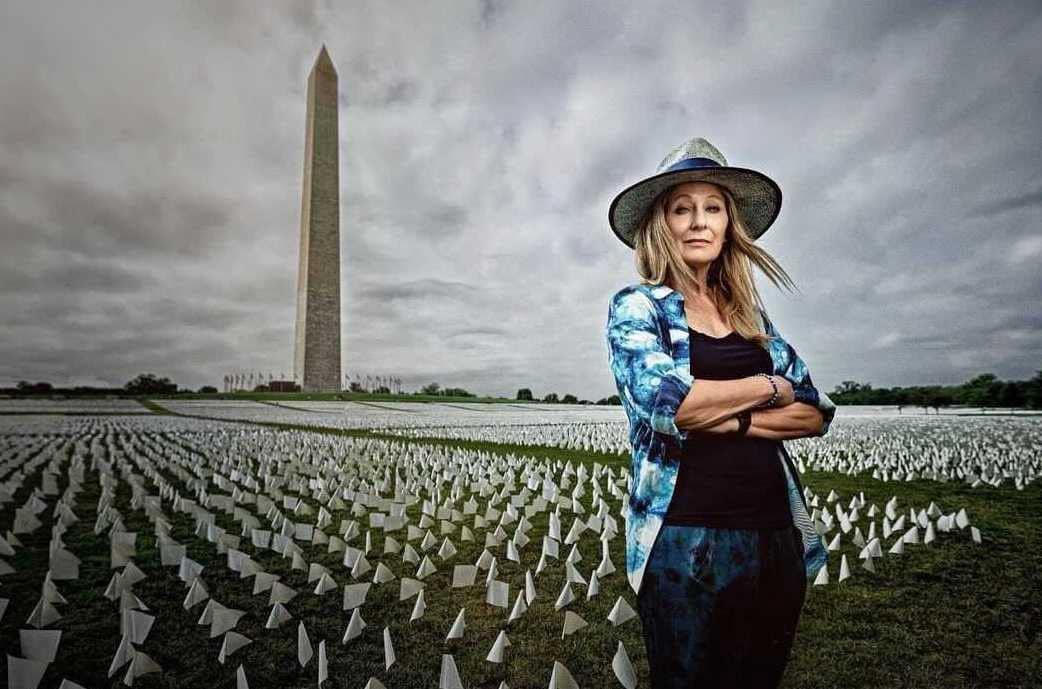For 25 years, visual artist Suzanne Brennan Firstenberg has comforted families in mourning as a hospice volunteer. And with each new family she’s consoled came lessons about the scope of grief, its impact, and the lack of spaces for people to express their deep sorrow.
Firstenberg brings those experiences to her latest work — a sprawling public art exhibition that honors the 684,400 people and counting who have died from COVID-19 in the United States. “In America: Remember” opened on Sept. 17 and runs through Oct. 3 on the National Mall in Washington, DC.
The display features lines of white flags, evocative of the white headstones in Arlington National Cemetery. Each flag represents an individual who has died from COVID during the pandemic. Visitors are encouraged to dedicate flags to friends and family who died from the illness. People who can’t visit Washington, DC., can share details about their loved one online through InAmericaFlags.org, and volunteers will inscribe the flag and plant it in the exhibit.
Since its opening, Firstenberg has seen middle-aged men break down for the first time. One woman told her she finally realized, after seeing the exhibit, that she wasn’t alone in her grief. And those reactions point to a bigger problem, Firstenberg said in an interview with Evermore.
“We need to stop and realize that America is hurting badly,” she said. “We have to stop and find a way to heal America. And we have to find a way to learn how to deal with death and loss in our community.”
Amazing acts of caring’
For Firstenberg, it all started last year with outrage after some were discounting the deaths of older adults and people of color, who face higher rates of serious health impacts and death from COVID. In fall 2020, as the total number of COVID deaths climbed into the 200,000s, she opened a similar exhibit, called “In America: How Could This Happen,” outside RFK Stadium in Washington.

Photograph by Philip Metlin
“I realized that the number of people who we had lost in this pandemic had become so large that it became easy to ignore,” she said.
“I had to, as a visual artist, use my art to help people identify the enormity of our loss.
“I knew I wanted to do art that would help people visually translate the cumulative death toll into something physical and something they could experience.”
But outrage hasn’t sustained her; the deep expressions of care and emotion from the people who visited the original exhibit did. She remembers a director from the Centers for Disease Control and Prevention who traveled from Georgia to snap a picture of the display and share it with their team. And there was an ER doctor who wrote out the names of a dozen patients he had lost to COVID on flags and pushed them into the ground before he went on to his next shift.
“I began last fall with a great deal of outrage,” she said. “But when I did that art installation, so many people brought their caring and their grief and their respect and love for those they have lost, and I saw such amazing acts of caring.”
Grief on ‘America’s stage’
This time, the exhibit extends beyond DC in two important ways. People who can’t travel to the nation’s capital can share details online about their loved one, who will then be honored with a flag in the exhibit. The placement along the National Mall, Firstenberg said, is another critical difference when considering the pandemic’s reach across the country.

Photograph by Jonathan Thorpe
“This is America’s stage,” she said of the National Mall. “We have brought America’s lost to its most important space.”
Just like the original exhibit, “In America” encourages participation. It’s designed that way, Firstenberg said, because she knows from her work with hospice that action supports the grieving process. Planting flags in the ground for loved ones is a public way for people to express their grief. The action of walking through the immense field of flags is another way to trigger understanding, she said.
As visitors glance down to read the names and stories of COVID’s victims, no longer is the death toll a number, but a representation of individuals — like the 99-year-old man who eschewed a ventilator to save somebody younger, as one flag notes, and the people who loved him.

Photograph by Jonathan Thorpe
“Each individual flag represents concentric circles of grief — the family, friends, the neighbors, the co-workers, the members of their faith community, and those medical workers who fought so hard to save that life,” she said. “They grieve too.”
Finding hope
Until the exhibit closes, each day at noon, Firstenberg will push more flags into the National Mall as the COVID death count ticks higher. But, despite being surrounded by this sprawling representation of death and grief, Firstenberg is hopeful.

